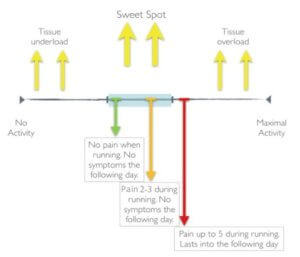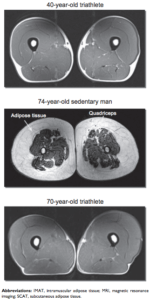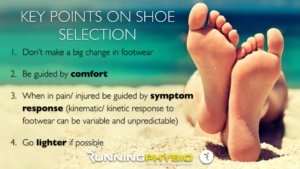by Josh Naunton, Physiotherapist
Running is a great way to keep fit and exercise which is partly why 3 million Australians participate in running each year1. Running can strengthen your immune system, prevent high blood pressure, improve your joint health, increase your strength, increase your bone density, help with weight loss and improve your mental health2. Contrary to the commonly held belief that running may be ‘bad’ for your knees, recent research demonstrates that a moderate amount of regular running is likely to protect osteoarthritis3.
Despite all of these benefits, you may find pain or injury limiting your enjoyment, your ability to participate or preventing you from being at your best. This is common for those who run often and more likely for those new to running. So, what really matters for running related injuries?
-
Force (Load) Matters
We can’t argue with or defy the laws of physics. Force matters – it must go somewhere. Our body must cope with the force that is created when running. When this force is absorbed will depend on your running speed and style. Running injuries occur most often when your body is exposed to force greater than your body’s tolerance to that load (force). For example, if your body is used to running 1km per week, then you suddenly run 30km in one week you have likely loaded your body’s tissue beyond its capacity. This may result in pain or injury (see diagram below).
The key factor in running related injuries is your body’s tissue tolerance and volume of load it is exposed to4. This can be influenced by how much and how often you run (training loads), your recent training history, your running style (running mechanics), fatigue, beliefs, stress and emotions5.

Figure with thanks to Tom Goom (http://www.running-physio.com/capacity-tests/)
-
Belief and fear matters.
Beliefs about injury as well as poor sleep, stress and anxiety can lead to an increased experience of pain, soreness or feelings of tightness6,7,8. Therefore, it is important that we consider other factors that may be contributing to running injury or pain. While your body’s tissue tolerance and exposure to load is important, running injuries are often more complex.
Pain is a perception produced by the brain as a response to perceived threat or danger9. Our brain interprets and weighs up the incoming information from our experiences. Pain is always a combination of physical factors (tissue tolerance and load) and non-physical factors (beliefs, attitudes, stress levels, moods, emotions, fear, anxiety, social context, what we have been told by others, previous experiences and expectations).
More information about pain and running can be found in this excellent blog written by Derek Griffin in the UK. http://www.running-physio.com/why-do-i-hurt/
-
Sleep
Quality sleep of adequate duration can improve performance, reduce pain and reduce injury10. If you are getting less than 6 hours sleep per night you may be at an increased risk of fatigue related injuries11. Teenagers sleeping less than 8 hours per night may increase injury risk by 1.7 times compared with those who sleep more than 8 hours12. The importance of sleep is demonstrated by some of the world’s best athletes as shown in the graph below. More information about sleep can be here. http://www.running-physio.com/sleep-your-way-to-better-recovery/

http://speedendurance.com/wp-content/uploads/2013/11/sleep-to-be-an-allstar_50290ef373f85.png
Managing Running Injuries – Is there a right or wrong way to run?
If you are injured or have pain when running, what can you do about it? Is there a right or wrong way to run? Should you simply rest and allow recovery to take place? If you are injured or experiencing pain when running, it is best to consider all of the factors contributing to your injury and address them accordingly. Each recovery plan is likely to include two main aims:
- Reduce tissue load when appropriate
- Increase tissue tolerance in order to cope with more load
Reducing Tissue Load
Reducing tissue load can be achieved by a small reduction in your running volume, complete rest is rarely necessary or advised. Changes in running speed or running terrain are also important to consider. The optimal solution will depend on your individual circumstances.
Tissue load reduction is best achieved by a change in running mechanics in order to shift force away from the symptomatic tissue, allowing time for recovery13. For example, increasing your step rate will naturally result in shorter steps and lower peak running forces. Other running cue examples such as ‘keep your waist band level’ or ‘run with more pressure on the inside of your foot’ are also useful depending on what change is required and the running mechanics observed. Video running analysis can provide feedback about which movement patterns may be contributing to your injury, as well as provide a visual cue to follow while adopting this change. Other considerations such as footwear or orthotics may also be important to consider in some instances.
https://pbs.twimg.com/media/DXX_2TPXUAE0p-7.jpg:large
Increasing Tissue Tolerance to Load
Cells sense and respond to mechanical forces leading to adaptation and structural change within tissue14. For example, increases in bone size and thickness are evident in baseball pitchers during their teen years and some of these benefits are maintained throughout life (see below left)15. Similarly, the images below on the right clearly demonstrate the body’s ability to build and maintain muscle mass with regular exercise as a triathlete compared with the loss of muscle in someone living a sedentary life16.


Consequently, if our body tissue is loaded consistently over time and challenged (but not beyond its capacity to cope and adapt), it will result in an improved tolerance to load. This is achieved primarily through exercise and conditioning.
Strength and conditioning exercise is an essential component to injury prevention and recovery. For more information about strengthening for runners you can find more information in this excellent article from Rich Willy, one of the world’s leading experts on running related injury.
http://semrc.blogs.latrobe.edu.au/5-myths-strength-training-endurance-running/
Key Messages
- Injury is typically a result of increased exposure to or sudden change in load beyond the tissue’s capacity to cope with or tolerate that demand
- Injury is influenced by physical and non-physical factors such as running mechanics, load demands, beliefs, attitudes, stress, fear, anxiety, expectations and sleep
- Good quality sleep can improve performance and reduce injury risk
- Injury recovery and prevention is not about the right or wrong way to run but rather a balance between load management and gradually increasing tissue tolerance to load
References:
- (2016). AusPlay: Participation data for the sport sector Retrieved from https://www.ausport.gov.au/__data/assets/pdf_file/0007/653875/34648_AusPlay_summary_report_accessible_FINAL_updated_211216.pdf
- Rowe, G. C., Safdar, A., & Arany, Z. (2014). Running forward: new frontiers in endurance exercise biology. Circulation, 129(7), 798-810. doi: 10.1161/circulationaha.113.001590
- Alentorn-Geli, E., Samuelsson, K., Musahl, V., Green, C. L., Bhandari, M., & Karlsson, J. (2017). The Association of Recreational and Competitive Running With Hip and Knee Osteoarthritis: A Systematic Review and Meta-analysis. Journal of Orthopaedic & Sports Physical Therapy, 47(6), 373-390. doi: 10.2519/jospt.2017.7137
- Dye, S. F. (2005). The Pathophysiology of Patellofemoral Pain: A Tissue Homeostasis Perspective. Clinical Orthopaedics and Related Research®, 436, 100-110. doi: 10.1097/01.blo.0000172303.74414.7d
- Messier, S. P., Martin, D. F., Mihalko, S. L., Ip, E., DeVita, P., Cannon, D. W., et al. A 2-Year Prospective Cohort Study of Overuse Running Injuries: The Runners and Injury Longitudinal Study (TRAILS). The American Journal of Sports Medicine, 0(0), 0363546518773755. doi: 10.1177/0363546518773755
- Schuh-Hofer, S., Wodarski, R., Pfau, D. B., Caspani, O., Magerl, W., Kennedy, J. D., et al. (2013). One night of total sleep deprivation promotes a state of generalized hyperalgesia: a surrogate pain model to study the relationship of insomnia and pain. Pain, 154(9), 1613-1621. doi: 10.1016/j.pain.2013.04.046
- Bingel, U., Wanigasekera, V., Wiech, K., Ni Mhuircheartaigh, R., Lee, M. C., Ploner, M., et al. (2011). The effect of treatment expectation on drug efficacy: imaging the analgesic benefit of the opioid remifentanil. Sci Transl Med, 3(70), 70ra14. doi: 10.1126/scitranslmed.3001244
- Weppler, C. H., & Magnusson, S. P. (2010). Increasing Muscle Extensibility: A Matter of Increasing Length or Modifying Sensation? Physical Therapy, 90(3), 438-449. doi: 10.2522/ptj.20090012
- Moseley, G. L. (2012). Teaching people about pain: why do we keep beating around the bush? Pain Manag, 2(1), 1-3. doi: 10.2217/pmt.11.73
- Simpson, N. S., Gibbs, E. L., & Matheson, G. O. (2017). Optimizing sleep to maximize performance: implications and recommendations for elite athletes. Scand J Med Sci Sports, 27(3), 266-274. doi: 10.1111/sms.12703
- Luke, A., Lazaro, R. M., Bergeron, M. F., Keyser, L., Benjamin, H., Brenner, J., et al. (2011). Sports-related injuries in youth athletes: is overscheduling a risk factor? Clin J Sport Med, 21(4), 307-314. doi: 10.1097/JSM.0b013e3182218f71
- Milewski, M. D., Skaggs, D. L., Bishop, G. A., Pace, J. L., Ibrahim, D. A., Wren, T. A., et al. (2014). Chronic lack of sleep is associated with increased sports injuries in adolescent athletes. J Pediatr Orthop, 34(2), 129-133. doi: 10.1097/bpo.0000000000000151
- Barton, C. J., Bonanno, D. R., Carr, J., Neal, B. S., Malliaras, P., Franklyn-Miller, A., et al. (2016). Running retraining to treat lower limb injuries: a mixed-methods study of current evidence synthesised with expert opinion. British Journal of Sports Medicine. doi: 10.1136/bjsports-2015-095278
- Khan, K. M., & Scott, A. (2009). Mechanotherapy: how physical therapists’ prescription of exercise promotes tissue repair. British Journal of Sports Medicine, 43(4), 247-252. doi: 10.1136/bjsm.2008.054239
- Warden, S. J., Mantila Roosa, S. M., Kersh, M. E., Hurd, A. L., Fleisig, G. S., Pandy, M. G., et al. (2014). Physical activity when young provides lifelong benefits to cortical bone size and strength in men. Proceedings of the National Academy of Sciences, 111(14), 5337-5342. doi: 10.1073/pnas.1321605111
- Wroblewski, A. P., Amati, F., Smiley, M. A., Goodpaster, B., & Wright, V. (2011). Chronic exercise preserves lean muscle mass in masters athletes. Phys Sportsmed, 39(3), 172-178. doi: 10.3810/psm.2011.09.1933


